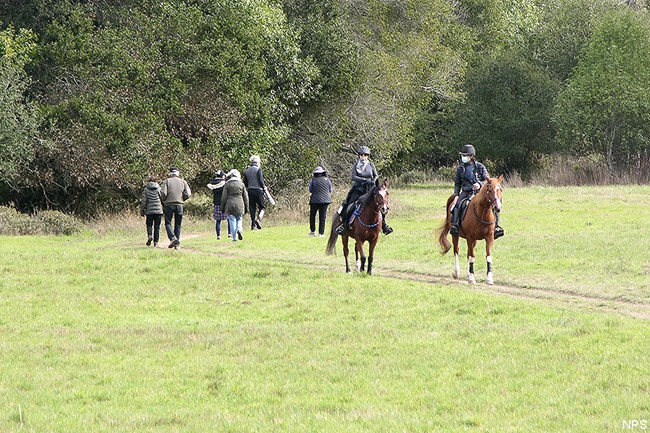
Horses and other pack animals are permitted on most established trails and beaches at Point Reyes National Seashore. They may not travel off trail because conditions are not maintained for their safety, and their presence can negatively impact the environment. You can download maps indicating which trails are designated for horse travel or stop by one of the park's Visitor Centers to pick up a trail map and obtain more information. Five Brooks Ranch (415-663-1570) is a full service riding stable with a concession to operate within the National Seashore. They offer a variety of activities and services, including guided trail rides. Rules and RegulationsRules pertaining to horses and horse riding at Point Reyes National Seashore are much the same as at other parks. A few of the rules that will apply to most horse riders include:
Additional regulations may be found in the Superintendent's Compendium. Horse Riding on BeachesWhile horse riding is welcome on park beaches, be aware that shorebirds may be nesting in more remote sections of beach. Please ride as close to the water's edge as is safe, and preferably below the high tide line when the tide is out, to reduce the risk of inadvertently stepping on any bird nests or scaring adult birds away from their eggs or chicks. Some beaches are seasonally closed to better protect nesting western snowy plovers. Invasive WeedsTo help control the spread of non-native plants, please:
More Information
Safety and EtiquetteTrail conditions vary throughout the year. Visit our Trail Guide and Trail Advisories and Closures pages or check with park staff at the Bear Valley Visitor Center in person or by phone (415-464-5100) before your ride for current trail information and special closures. There are also some trails and areas of the park described below that are permanently closed to horses and pack animals. Stinging NettleStinging nettle is a common plant at Point Reyes National Seashore and some trails may be overgrown with nettle at certain times of the year, especially during the spring and summer. Horses can react strongly if they are stung by stinging nettle's small needle-like hairs. Stung horses may begin to panic and leave the trail, thereby moving deeper into the nettles. In extreme cases, horses have died after extensive exposure to this plant. Both horse and rider should avoid this plant. The best way to do this is to stay in the center of the trail. Yellow JacketsHorse riders should pay attention to signs at trailheads warning about yellow jackets, in addition to being alert for increasing numbers of yellow jackets. As a horse passes near a yellow jacket nest, it can shake the nest. Yellow jackets will then swarm out to defend the nest. If you are on a horse that is being attacked by yellow jackets, you will definitely want to promptly move out of the area. Some horses might panic upon being stung and may start bucking and bolting. Use your knowledge of your horse's temperament and your best judgment to resolve the situation. Other Safety and Etiquette GuidelinesHorse riding etiquette and safety guidelines at Point Reyes National Seashore are much the same as at other parks:
Multimedia:Horse riders and other visitors to Point Reyes may find our Wilderness Videos page to be of interest. There we feature multiple videos about the Phillip Burton Wilderness and Leave No Trace® outdoor ethics. Areas Closed to Horses and Pack AnimalsMount Wittenberg TrailMount Wittenberg Trail is closed to horses until further notice due to damage from the Woodward Fire. Storm DamageSevere rutting occurred on the Bolema Trail during the January 2023 rainstorms. The rutting may make the trail too hazardous for equestrians to safely use. Please avoid riding horses on the Bolema Trail until further notice. Weekend and Holiday ClosuresOn Saturdays, Sundays and holidays, the following trails (Map - 140 KB PDF) are closed to horses and pack animals:
Year-round ClosuresHorses and pack animals are not allowed in the following areas at any time:
Seasonal ClosuresThe following areas have seasonal closures:
LlamasAs of May 30, 2023, llamas are prohibited from all areas within Point Reyes National Seashore.
Popular Trail RidesFrom Bear Valley
From Five Brooks Trailhead
Camping with Horses and Pack AnimalsBackcountry CampgroundsCamping is by permit only in three established campgrounds. All advance reservations are now handled by Recreation.gov. Visit our Backcountry Camping page for more information. The maximum number of horses or pack animals (e.g., mules or burros) permitted overnight at Sky, Coast, and Wildcat Campgrounds is six. Horses and other pack animals are not permitted overnight at Glen Camp. Pack animals and horses must be tied to hitching rails. Do not hitch animals to water supply faucets or picnic tables. Grazing in the wilderness areas is prohibited. All feed for the animals must be packed in with you. In order to control the spread of non-native plants, please bring in only weed-free feed. There is usually potable water available at each of the camps from faucets. Sky and Wildcat Campgrounds also have a water trough for horses and pack animals. Commercial Horseback TripsA Commercial Use Authorization is required for commercial horseback riding or pack trains into the backcountry. Contact the Special Park Uses Office by email for more information. Five Brooks Horse CampOvernight camping is also available during the summer and fall at the Five Brooks Horse Camp. This is a privately managed camp located on Highway 1, 0.4 kilometer (1/4 mile) north of Five Brooks Trailhead. Please call the Five Brooks Ranch for reservations at 415-390-6040. |
Last updated: May 15, 2025
